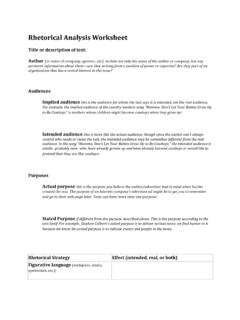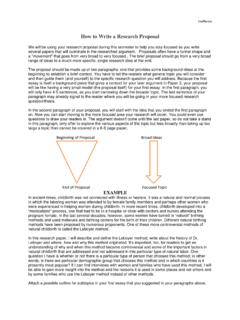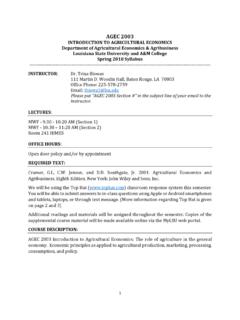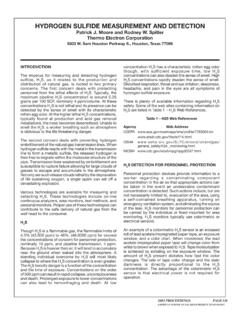Transcription of Standard Operating Procedure Chemical Storage Guidelines ...
1 Standard Operating Procedure Chemical Storage Guidelines Page 1 of 10 Investigator: General Safety Location: EHS Revision: DOC # Active Date: 6/9/17 Retired Date: PURPOSE: Proper Storage is needed to minimize the hazards associated with accidentally mixing incompatible chemicals. Due to the diverse individual properties of chemicals that may be located in a Chemical use area, proper Storage may be complicated. This SOP provides general safety procedures for Chemical Storage . Specific instructions on Chemical Storage may be obtained from the MSDS, container label, or by contacting OES. SCOPE: This Procedure applies to all Louisiana State University Personnel that use and handle chemicals.
2 It is the intent of this guideline to provide information on the safe Storage of chemicals and afford employee protection from potential health and physical hazards associated with accidentally mixing incompatible chemicals. RESPONSIBILITIES: Only trained and qualified personnel shall be allowed to handle hazardous materials. Supervisors are responsible for ensuring that personnel are trained to handle chemicals and that all Chemical are store in a safe manner. The Chemical incompatibilities discussed below are by no means exhaustive. As a result, it is important for laboratory personnel to thoroughly research the properties of the chemicals they are using. Material Safety Data Sheets (MSDSs) have sections on Chemical incompatibility.
3 The container's label should also provide Storage Guidelines DEFINITIONS: Pyrophoric Substance - Materials which will react with the air to ignite when exposed, , white phosphorus. Oxidizing Agent Reactive material that oxidizes another substance and is reduced. Acid Corrosive material that that produces H+ (aq) ions in aqueous solution. Strong acids ionize completely or almost completely in dilute aqueous solution. Weak acids ionize only slightly. Base Corrosive material that produces OH (aq) ions in aqueous solution. Strong bases are soluble in water and are completely dissociated. Weak bases ionize only slightly. Flammable - A liquid as defined by NFPD and DOT as having a flash point below C (100 F).
4 REFERENCES: Standard Operating Procedure Chemical Storage Page 2 of 10 Investigator: General Safety Location: EHS Revision: DOC # Active Date: 6/9/17 Retired Date: Manufacturing Chemists' Association, Guide for Safety in the Chemical Laboratory, pp. 215-217, Van Nostrand Reinhold, 2nd Edition "Safe Chemical Storage : A Pound of Prevention is Worth a Ton of Trouble" by David Pipitone and Donald Hedberg, Journal of Chemical Education, Volume 59, Number 5, May 1982 "Fire Protection Guide on Hazardous Materials," NFPA, 1978 MATERIALS and/or EQUIPMENT: Personal Protective Equipment PROCEDURES: Know the properties of the chemicals used. In general, chemicals should be separated according to the following categories: solvents , which include flammable/combustible liquids and halogenated hydrocarbons ( , acetone, benzene, ethers, alcohols) Note: Store glacial acetic acid as a flammable liquid Inorganic mineral acids ( , nitric, sulfuric, hydrochloric, and perchloric acids).
5 Bases ( , sodium hydroxide, ammonium hydroxide) Oxidizers Poisons Explosives or unstable reactives, such as picric acid. Store separately outdoors in flammable Storage cabinets. An inventory of all chemicals must be maintained. Inventories must include the full Chemical name, location of Storage , and associated hazard ( corrosive or flammable Inventories must be updated annually and signed by the person performing the update. Chemicals purchased throughout the year must be added to the inventory as soon as they are brought into the work area. Post Chemical inventories inside the room with a hazard summary posting on the door for emergency response purposes. Ensure that all containers are in good condition, properly capped, and labeled.)
6 If you are using short hand names or acronyms on any solutions, reagents, or aliquots of chemicals, you must maintain a cross-reference sheet that defines the short hand name or acronym in use such as EtOH = ethanol or PBS=phosphate buffered saline. Review this list annually to ensure that all short hand names or acronyms in use are recorded. Standard Operating Procedure Chemical Storage Page 3 of 10 Investigator: General Safety Location: EHS Revision: DOC # Active Date: 6/9/17 Retired Date: Store all hazardous liquid chemicals in drip trays that are chemically resistant. Photo trays provide good containment and are widely used at the Lab. Install Plexiglas lips or use equivalent means to prevent materials from falling off Storage shelves.
7 Avoid storing chemicals on countertops or in fume hoods except for those being currently used. Avoid storing chemicals above eye level. Select low shelves or cabinets for heavy containers. Never store chemicals or any other item closer than 18 to the ceiling. Storing an item close to the ceiling will impede the effectiveness of automatic fire suppression systems. Do not store chemicals on the floor. Chemical containers could present a tripping hazard or could be knocked over causing a spill. Label all containers (squeeze bottles and Nalgene bottles) to which hazardous materials are transferred with the identity of the substance and its hazards. Be aware that squeeze bottles and Nalgene bottles have varying resistances to different chemicals.
8 Limit the amount of chemicals stored to the minimum required. Avoid exposure of chemicals to heat or direct sunlight. This may lead to the deterioration of Storage containers as well as the degradation of the chemicals. Use approved corrosive Storage cabinets (constructed of chemically resistant components) for storing acids and bases. Use flammable Storage cabinets to store flammable liquids. Refrigerators used for storing chemicals, samples or media must be labeled with words to the effect as follows: Caution Do Not Store Food Or Beverages In This Refrigerator . Refrigerators used for food Storage in or near work areas (shops and labs) must be labeled with words to the effect as: Notice Food May Be Stored In this Refrigerator.
9 Labels may be fabricated by users provided they are legible and securely affixed to the refrigerator. Refrigerators used for food and beverage which are located in lunch rooms and office buildings, where there is no shop or lab type Chemical usage do not require any posting. Refrigerators and freezers for storing flammable liquids (including ethanol) must be designed, constructed and approved for that purpose. Domestic refrigerator/freezers as well as units that have been modified to remove spark sources are not acceptable alternatives. Standard Operating Procedure Chemical Storage Page 4 of 10 Investigator: General Safety Location: EHS Revision: DOC # Active Date: 6/9/17 Retired Date: Avoid mixing incompatible waste materials.
10 A number of serious laboratory accidents have occurred when people have poured incompatible waste materials into hazardous waste containers. Use separate waste containers for each type of waste. Storage ACCORDING TO HAZARD CLASSES The following Guidelines are provided for the safe Storage of hazardous materials in accordance with their hazard classes: Acids Segregate acids from reactive metals such as sodium, potassium, magnesium. Segregate oxidizing acids from organic acids, flammable and combustible materials. Segregate acids from chemicals which could generate toxic or flammable gases upon contact, such as sodium cyanide, iron sulfide , calcium carbide Segregate acids from bases.










